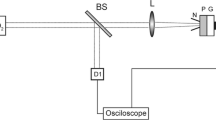Abstract
The performance of “ablation mode” laser propulsion thrusters can be improved obviously by nozzle constraint. The nozzle geometry of “ablation mode” laser propulsion thrusters has been studied experimentally with CO2 lasers. Experimental results indicate that the propulsion performance of cylindrical nozzle thrusters is better than expansionary nozzle thrusters at the same lengths. The cylindrical nozzle thrusters were optimized by different laser energies. The results show that two important factors, the length-to-diameter ratio α and the thruster diameter to laser-spot diameter ratio β, affect the propulsion performance of the thruster obviously. The momentum coupling coefficient C m increases with the increase of α, while C m increases at first and then decreases with the increase of β.









Similar content being viewed by others
References
A. Kantrowi, Propulsion to orbit by ground-based lasers. Astronaut Aeronaut 10(5), 74 (1972)
W.O. Schall, et al., Lightcraft experiments in Germany, in High-Power Laser Ablation III, ed. by C.R. Phipps (SPIE, Bellingham, 2000), pp. 472–481
T. Zhiping, et al., Experimental study of the momentum coupling coefficient with the pulse frequency and ambient pressure for air-breathing laser propulsion. in AIP Conference Proceedings, vol 830 (2006), pp. 104–113
P. Gong et al., Experimental investigation of the effects of laser parameters on laser propulsion. Chin. Opt. Lett. 2(9), 538–540 (2005)
Z. Tang, et al., Experimental study of the momentum coupling coefficient with the pulse frequency and ambient pressure for air‐breathing laser propulsion, in Beamed energy propulsion: fourth international symposium on beamed energy propulsion (AIP Publishing, 2006)
A. Sasoh et al., Impulse-scaling in a laser-driven in-tube accelerator. Appl. Phys. A Mater. Sci. Process. 77(2), 349–352 (2003)
H. Katsurayama, K. Komurasaki, Y. Arakawa, A preliminary study of pulse-laser powered orbital launcher. Acta Astronaut. 65(7–8), 1032–1041 (2009)
C. Phipps et al., Review: laser-ablation propulsion. J. Propul. Power 26(4), 609–637 (2010)
J.E. Sinko, et al., CO2 Laser ablation area scaling and redeposition on flat polyoxymethylene targets, in International Symposium on High Power Laser Ablation, ed. by C.R. Phipps (2010), pp. 538–547
S. Scharring et al., Review on Japanese–German–US cooperation on laser-ablation propulsion, in Beamed Energy Propulsion: Seventh International Symposium, ed. by H.A. Eckel, S. Scharring (2011)
M.R. Ahmad et al., Plasma confinement to enhance the momentum coupling coefficient in ablative laser micro-propulsion: a novel approach. Laser Phys. Lett. 12(7), 076101 (2015)
C. Toro et al., Design and characterization of nozzles and solid propellants for IR laser propulsion. Appl. Phys. A 117(1), 43–47 (2014)
M. Ushio et al., Effect of laser supported detonation wave confinement on termination conditions. Shock Waves 18(1), 35–39 (2008)
J. Li et al., Multi-use laser impulse pendulum and laser propulsion parameters measurement. Chin. Opt. Lett. 2(11), 650–653 (2004)
J.E. Sinko, A. Sasoh, Review of CO2 laser ablation propulsion with polyoxymethylene. Int. J. Aerosp. Innov. 3(2), 93–130 (2011)
C. Phipps, et al., A review of laser ablation propulsion, in International Symposium on High Power Laser Ablation 2010, ed. by C.R. Phipps (American Institute of Physics, Melville, 2010), pp. 710–722
L. Jiao, et al. Application of energetic materials in laser ablative micropropulsion. Int. J. Energ. Mater. Chem. Propuls. 14(1), 107–112 (2015)
L. Jiao et al., Research on applications of rectangular beam in micro laser propulsion. Appl. Surf. Sci. 301, 481–487 (2014)
J.L. Gottfried, Influence of exothermic chemical reactions on laser-induced shock waves. Phys. Chem. Chem. Phys. 16(39), 21452–21466 (2014)
C. Phipps, J. Luke, T. Lippert, Laser ablation of organic coatings as a basis for micropropulsion. Thin Solid Films 453, 573–583 (2004)
Y.A. Rezunkov, Laser reactive thrust. Review of research. J. Opt. Technol. 74(8), 526–535 (2007)
L. Li et al., Experimental investigation of laser propulsion for polyoxymethylene propellants seeded with metallic particles. Int. J. Aerosp. Innov. 3(2), 77–84 (2011)
A.A. Ageichik et al., Detonation of CHO working substances in a laser jet engine. Tech. Phys. 54(3), 402–409 (2009)
Acknowledgments
This research was supported by the National Natural Science Foundation of China (Grant Nos.: 11302221 and 51374189) and the Natural Science Foundation of Jiangsu Province (Grant No.: BK20151482).
Author information
Authors and Affiliations
Corresponding author
Additional information
Long Li and Long Jiao have contributed equally to this work.
Rights and permissions
About this article
Cite this article
Li, L., Jiao, L., Tang, Z. et al. Effect of nozzle geometry on the performance of laser ablative propulsion thruster. Appl. Phys. A 122, 511 (2016). https://doi.org/10.1007/s00339-016-0040-9
Received:
Accepted:
Published:
DOI: https://doi.org/10.1007/s00339-016-0040-9




